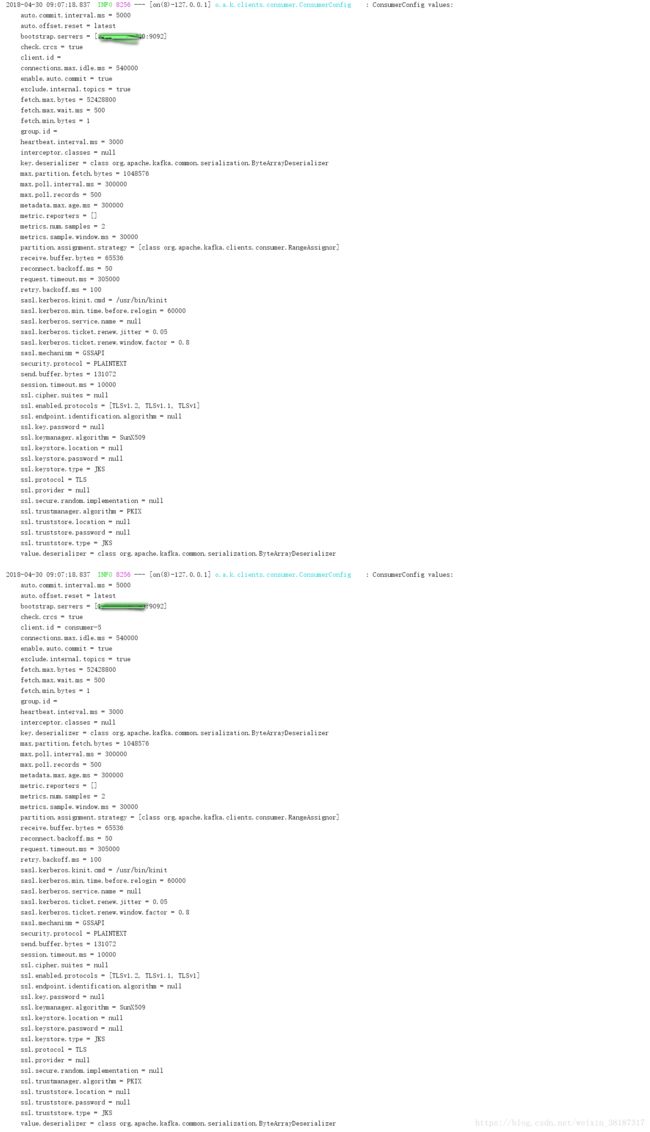SpringCloud Stream消息驱动模块(使用kafka)
说明
之前我们使用的是RabbitMQ与Stream的结合完成消息驱动模块,这次使用Kafka与Stream。
目标
本文的目的在于结合Kafka与Stream来处理消息通信,采取自定义编写Sink(input)和Source(output)来设置多通道消息和消费组、消费分区等操作实现基本的消息驱动的微服务架构。
快速开始
环境:服务器端java 1.8、kafka 0.10.1.1、zookeeper 3.4.8(kafka内置);编程环境java 1.8、SpringBoot 1.5.2.RELEASE、SpringCloud Dalston.SR2。更换版本后注意服务器端kafka版本与SpringCloud使用的kafka版本一致
1 修改服务器端kafka配置文件
1)安装kafka与kafka-manager -> kafka与kafka-manager的安装使用
2)切换到安装目录,修改server.properties配置文件:
cd /***/kafka_2.10-0.10.1.1/
vim config/server.properties修改如下
# Licensed to the Apache Software Foundation (ASF) under one or more
# contributor license agreements. See the NOTICE file distributed with
# this work for additional information regarding copyright ownership.
# The ASF licenses this file to You under the Apache License, Version 2.0
# (the "License"); you may not use this file except in compliance with
# the License. You may obtain a copy of the License at
#
# http://www.apache.org/licenses/LICENSE-2.0
#
# Unless required by applicable law or agreed to in writing, software
# distributed under the License is distributed on an "AS IS" BASIS,
# WITHOUT WARRANTIES OR CONDITIONS OF ANY KIND, either express or implied.
# See the License for the specific language governing permissions and
# limitations under the License.
# see kafka.server.KafkaConfig for additional details and defaults
############################# Server Basics #############################
# The id of the broker. This must be set to a unique integer for each broker.
broker.id=0
# Switch to enable topic deletion or not, default value is false
delete.topic.enable=true
############################# Socket Server Settings #############################
# The address the socket server listens on. It will get the value returned from
# java.net.InetAddress.getCanonicalHostName() if not configured.
# FORMAT:
# listeners = security_protocol://host_name:port
# EXAMPLE:
# listeners = PLAINTEXT://your.host.name:9092
listeners=PLAINTEXT://0.0.0.0:9092
# Hostname and port the broker will advertise to producers and consumers. If not set,
# it uses the value for "listeners" if configured. Otherwise, it will use the value
# returned from java.net.InetAddress.getCanonicalHostName().
# 最好像这样使用地址映射,直接填写ip外网可能会连接不上kafka
advertised.listeners=PLAINTEXT://YUNLINGFLY-Backup0:9092
# The number of threads handling network requests
num.network.threads=3
# The number of threads doing disk I/O
num.io.threads=8
# The send buffer (SO_SNDBUF) used by the socket server
socket.send.buffer.bytes=102400
# The receive buffer (SO_RCVBUF) used by the socket server
socket.receive.buffer.bytes=102400
# The maximum size of a request that the socket server will accept (protection against OOM)
socket.request.max.bytes=104857600
############################# Log Basics #############################
# A comma seperated list of directories under which to store log files
log.dirs=/usr/springboottest/kafka_2.10-0.10.1.1/somelogs
# The default number of log partitions per topic. More partitions allow greater
# parallelism for consumption, but this will also result in more files across
# the brokers.
num.partitions=1
# The number of threads per data directory to be used for log recovery at startup and flushing at shutdown.
# This value is recommended to be increased for installations with data dirs located in RAID array.
num.recovery.threads.per.data.dir=1
############################# Log Flush Policy #############################
# Messages are immediately written to the filesystem but by default we only fsync() to sync
# the OS cache lazily. The following configurations control the flush of data to disk.
# There are a few important trade-offs here:
# 1. Durability: Unflushed data may be lost if you are not using replication.
# 2. Latency: Very large flush intervals may lead to latency spikes when the flush does occur as there will be a lot of data to flush.
# 3. Throughput: The flush is generally the most expensive operation, and a small flush interval may lead to exceessive seeks.
# The settings below allow one to configure the flush policy to flush data after a period of time or
# every N messages (or both). This can be done globally and overridden on a per-topic basis.
# The number of messages to accept before forcing a flush of data to disk
#log.flush.interval.messages=10000
# The maximum amount of time a message can sit in a log before we force a flush
#log.flush.interval.ms=1000
############################# Log Retention Policy #############################
# The following configurations control the disposal of log segments. The policy can
# be set to delete segments after a period of time, or after a given size has accumulated.
# A segment will be deleted whenever *either* of these criteria are met. Deletion always happens
# from the end of the log.
# The minimum age of a log file to be eligible for deletion
log.retention.hours=168
# A size-based retention policy for logs. Segments are pruned from the log as long as the remaining
# segments don't drop below log.retention.bytes.
#log.retention.bytes=1073741824
# The maximum size of a log segment file. When this size is reached a new log segment will be created.
log.segment.bytes=1073741824
# The interval at which log segments are checked to see if they can be deleted according
# to the retention policies
log.retention.check.interval.ms=300000
############################# Zookeeper #############################
# Zookeeper connection string (see zookeeper docs for details).
# This is a comma separated host:port pairs, each corresponding to a zk
# server. e.g. "127.0.0.1:3000,127.0.0.1:3001,127.0.0.1:3002".
# You can also append an optional chroot string to the urls to specify the
# root directory for all kafka znodes.
zookeeper.connect=localhost:2181
# Timeout in ms for connecting to zookeeper
zookeeper.connection.timeout.ms=400000
# 配置的超时时间太短,Zookeeper没有读完Consumer的数据,连接就被Consumer断开了!
zookeeper.session.timeout.ms=400000注意事项:kafka 0.10.1.1不需要配置advertised.host.name,advertised.port参数,advertised.listeners包括上述两项;listeners=PLAINTEXT://0.0.0.0:9092表示绑定所有网卡地址
kafka详细配置参数 --> kafka配置详细参数说明
3)修改hosts文件(Windows的hosts文件在C:\Windows\System32\drivers\etc\目录下):
cd ~
vim /etc/hosts添加一行映射如下(注意填写服务器外网地址):
xxx.xxx.xxx.xxx YUNLINGFLY-Backup04)修改编程环境的hosts文件和步骤3一样
5)重启服务器reboot(Windows可以使用ipconfig/flushdns刷新hosts配置),重新开启Zookeeper服务,开启kafka-server(具体命令查看kafka与kafka-manager安装使用)。
配置到此结束。
2 编写程序
其实使用kafka和RabbitMQ的区别是在于配置文件的不同,所以不重复写了,具体代码参照我的另一篇博客 -> SpringCloud Stream的使用
需要改变的地方是pom.xml引入的包,将spring-cloud-starter-stream-rabbitmq改为spring-cloud-starter-stream-kafka(SpringCloud与SpringBoot版本在最开始说明了):
org.springframework.cloud
spring-cloud-starter-stream-kafka
application.yml删除spring.rabbit属性,添加如下代码:
spring:
cloud:
stream:
# 设置成使用kafka
kafka:
binder:
# Kafka的服务端列表,默认localhost
brokers: xxx.xxx.xxx.xxx:9092
# Kafka服务端连接的ZooKeeper节点列表,默认localhost
zkNodes: xxx.xxx.xxx.xxx:2181
minPartitionCount: 1
autoCreateTopics: true
autoAddPartitions: true运行结果
在这之前还可以看到kafka的配置参数如:
使用命令bin/kafka-topics.sh --list --zookeeper localhost:2181也可以看到我们创建的通道


